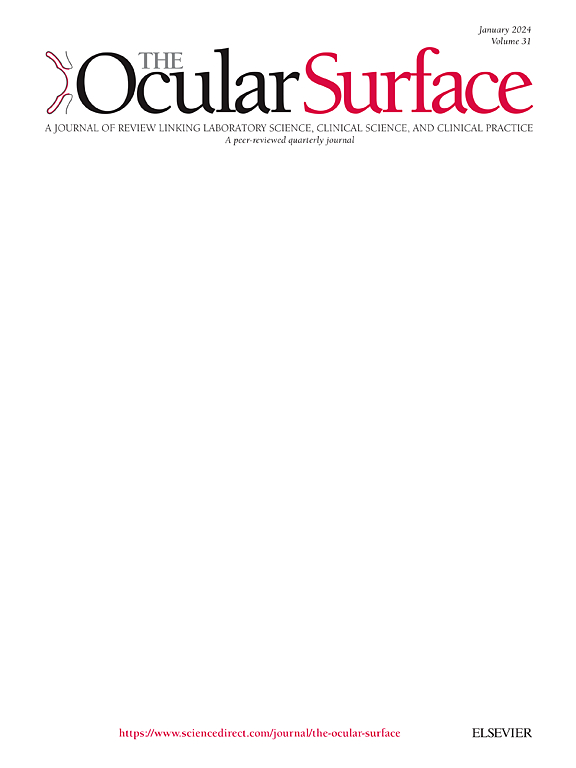通过克隆分析评估睑板腺干/祖细胞的克隆生长潜力。
IF 5.6
1区 医学
Q1 OPHTHALMOLOGY
引用次数: 0
摘要
目的:克隆分析是评价干细胞/祖细胞在表皮或角膜缘研究中的状态的一种可行方法。本研究旨在通过克隆分析评价睑板腺(MG)上皮细胞的克隆生长潜力。方法:分离小鼠和人MG组织,与3T3饲养细胞共培养。对MG克隆进行K14、K6a和PPARγ免疫荧光染色。根据克隆面积对全息克隆、分裂克隆和仿克隆进行分类。三重染色和瓦片扫描提供了MG克隆形成的全面视图。MG导管克隆和腺泡克隆分别培养,比较干细胞/祖细胞特性。我们使用克隆分析进一步评估了年龄相关性MGD (ARMGD)小鼠模型以及两个不同年龄的人MG样本。结晶紫染色法评价克隆形成效率(CFE)。结果:小鼠和人MG上皮细胞均在饲养层上形成克隆,且随时间增大。分化无性系中K14、K6a和PPARγ的表达在发育过程中降低。小鼠MG克隆中全息克隆和mero克隆的CFE约为1‰,人MG克隆中全息克隆和mero克隆的CFE约为2.5‰和5.6‰。由导管上皮细胞生成的全息克隆的CFE显著高于腺泡克隆。在ARMGD小鼠模型和人类样本中,MG克隆的克隆更小,CFE减少,K14+、K6a+和PPARγ+细胞减少。结论:克隆分析可以有效地评估MGD中干细胞和祖细胞,揭示这些细胞在MGD条件下的恶化。本文章由计算机程序翻译,如有差异,请以英文原文为准。
Assessment of the clonal growth potential of meibomian gland stem/progenitor cells via clonal analysis
Purpose
Clonal analysis is a feasible method to evaluate the status of stem/progenitor cells in epidermal or limbus investigations. This study aimed to evaluate the clonal growth potential of meibomian gland (MG) epithelial cells using clonal analysis.
Methods
Mouse and human MG tissues were isolated and cocultured with 3T3 feeder cells. Immunofluorescent staining of K14, K6a, and PPARγ on MG clones was applied. Holoclones, meroclones and paraclones were categorized based on clonal area. Triple staining and tile scans provided a comprehensive view of MG clone formation. MG ductal and acinar clones were cultured separately to compare stem/progenitor cell characteristics. We further evaluated an age-related MGD (ARMGD) mouse model along with two human MG samples of different ages using clonal analysis. Crystal violet staining was employed to assess clone formation efficiency (CFE).
Results
Both mouse and human MG epithelial cells formed clones on the feeder layers, which enlarged over time. The expression of K14, K6a, and PPARγ was decreased in differentiated clones during development. The CFE of holoclones and meroclones was approximately 1 ‰ in mouse MG clones and approximately 2.5 ‰ in holoclones and 5.6 ‰ in meroclones in human MG clones. The CFE of holoclones generated by ductal epithelial cells was significantly higher than did acinar clones. In the ARMGD mouse model and human samples, smaller clones, reduced CFE, and decreased K14+, K6a+, and PPARγ+ cells in MG clones were identified.
Conclusions
Clonal analysis effectively evaluates stem and progenitor cells in MGs, revealing deterioration in these cells under MGD conditions.
求助全文
通过发布文献求助,成功后即可免费获取论文全文。
去求助
来源期刊

Ocular Surface
医学-眼科学
CiteScore
11.60
自引率
14.10%
发文量
97
审稿时长
39 days
期刊介绍:
The Ocular Surface, a quarterly, a peer-reviewed journal, is an authoritative resource that integrates and interprets major findings in diverse fields related to the ocular surface, including ophthalmology, optometry, genetics, molecular biology, pharmacology, immunology, infectious disease, and epidemiology. Its critical review articles cover the most current knowledge on medical and surgical management of ocular surface pathology, new understandings of ocular surface physiology, the meaning of recent discoveries on how the ocular surface responds to injury and disease, and updates on drug and device development. The journal also publishes select original research reports and articles describing cutting-edge techniques and technology in the field.
Benefits to authors
We also provide many author benefits, such as free PDFs, a liberal copyright policy, special discounts on Elsevier publications and much more. Please click here for more information on our author services.
Please see our Guide for Authors for information on article submission. If you require any further information or help, please visit our Support Center
 求助内容:
求助内容: 应助结果提醒方式:
应助结果提醒方式:


